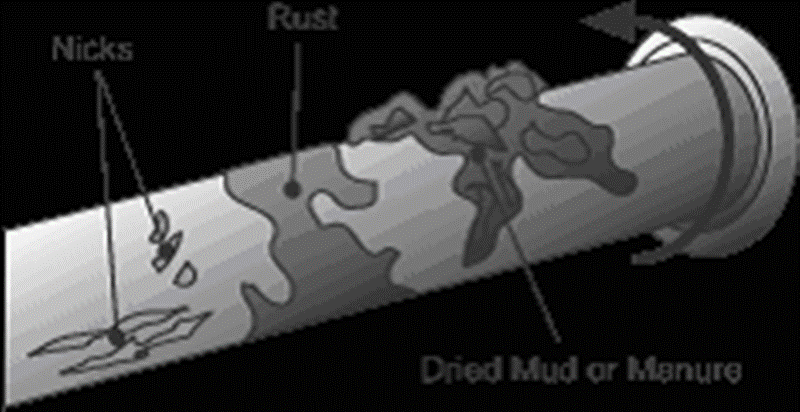
(Wrap Point. Source: University of Minnesota)
Use the following format to cite this article:
Mechanical hazards: Wrap point. (2012). Farm and Ranch eXtension in Safety and Health (FReSH) Community of Practice. Retrieved from http://www.extension.org/pages/66373/mechanical-hazards:-wrap-points.
Any type of exposed rotating machine component can pose a wrap point or entanglement point hazard. Almost all field and stationary machines on a farm or ranch have one or more rotating parts, many of which present wrap point hazards. Examples of wrap points include power take-off (PTO) and secondary shafts on any machine, post-hole diggers, augers, and tines or blades on manure spreaders.
One of the most common wrap point hazards is the PTO unit, which rotates at a speed of at least 540 rpm, or nine rotations per second, when operating at full recommended speed. If a piece of a person’s clothing or a shoelace is caught in a PTO rotating at this speed, the person could be entangled around the shaft in less than a second. A smooth shaft can be an entanglement hazard because force from the rotating shaft may be adequate to hold clothes against the shaft. Because clothing is more likely to catch on an uneven surface, the hazard increases when the shaft is not round; when there is dirt or debris such as mud, rust, or manure on the shaft (as shown in the image above); or when the shaft is nicked. Clothing can also become snagged on universal joints, keys, and fastening devices.
Potential Injuries
Wrap point incidents can result in the following injuries:
- Severe contusions
- Cuts
- Burns
- Dislocations
- Broken bones
- Amputations
- Scalping
Incidents can result in fatalities if injuries are sufficiently severe.
Safety Precautions
You can reduce the risk of a wrap point incident by taking the actions that follow:
- Identify machines that may have wrap points.
- Be aware that fatigue, carelessness, and haste contribute to entanglement incidents.
- Make sure the PTO shaft, driveline, and universal joint are properly shielded and maintained.
- Wear clothing that fits well because close-fitting clothing is less likely to be pulled into moving parts.
- Remove all jewelry and tie back long hair or secure it under a hat when working near a machine that has a wrap point.
- Before dismounting a tractor, always take the PTO out of gear and shut down the engine.
- Turn off the machine and wait for rotating parts to come to a complete stop before starting any type of maintenance.
- If a shield has been removed to complete maintenance, make sure the shield is securely in place prior to operating the equipment.
- Replace damaged manufacturer-installed warning labels and place warning labels on unlabeled areas.
- For better visibility of wrap point hazards, consider painting those areas a bright color to provide an additional alert to the hazard.
- Choose equipment that is properly guarded rather than using older equipment that may lack guards such as PTO master shields.
Resources
Click here to view a video about wrap point hazards from Pennsylvania State University’s Agricultural Safety and Health Program.
Use the following format to cite this article:
Mechanical hazards: Wrap point. (2012). Farm and Ranch eXtension in Safety and Health (FReSH) Community of Practice. Retrieved from http://www.extension.org/pages/66373/mechanical-hazards:-wrap-points.
Sources
Agricultural equipment and machine hazards. (2016). The Ohio State University. Retrieved from http://agsafety.osu.edu/programs/cfaes-osha/ag-equipment-machine-hazards.
American Society of Agricultural and Biological Engineers, 2009. ANSI/ASABE S604. Safety for power take-off (PTO), implement input drivelive (IID), implement input connection (IIC), and auxiliary power take-off (aux. PTO) for agricultural field equipment. St. Joseph, MI. Retrieved from https://elibrary.asabe.org/.
American Society of Agricultural and Biological Engineers, 2011. ANSI/ASABE AD500-1:2004. Agricultural tractors – Rear-mounted power take-off types 1,2 and 3 – Part 1: General specifications, safety requirements, dimensions for master shield and clearance zone. St. Joseph, MI. Retrieved from https://elibrary.asabe.org/.
FARM-HAT. (2010). Pennsylvania State University, Department of Agricultural and Biological Engineering, Agricultural Safety and Health. Retrieved from https://extension.psu.edu/farm-agriculture-rural-management-hazard-analy….
Harshman, W., Yoder, A., Hilton, J., & Murphy, D. (2011) Mechanical hazards. HOSTA Task Sheet 3.1. Pennsylvania State University Agricultural and Biological Engineering Department. Retrieved from http://articles.extension.org/sites/default/files/Version%203.%20January….
Safety note #11: Power take-off safety. (2004) University of California, Agriculture and Natural Resources, Environmental Health and Safety. Retrieved from http://safety.ucanr.org/files/1364.pdf.
